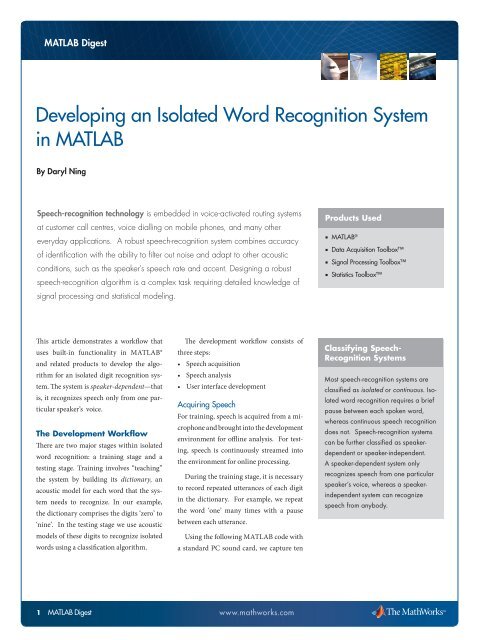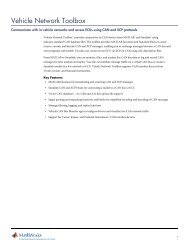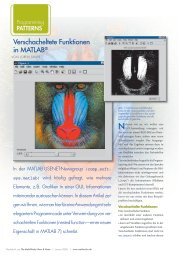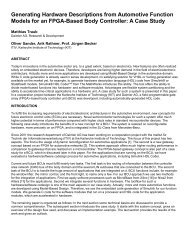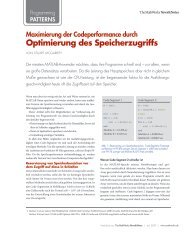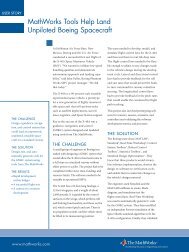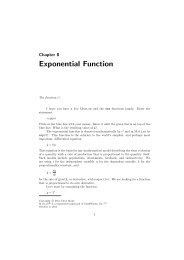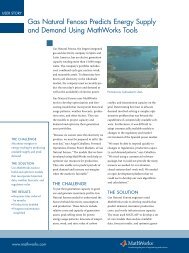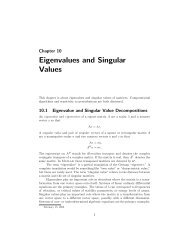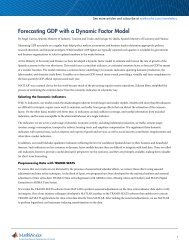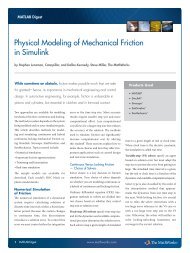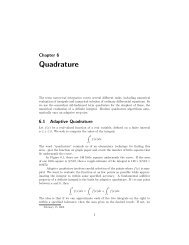Developing an Isolated Word Recognition System in ... - MathWorks
Developing an Isolated Word Recognition System in ... - MathWorks
Developing an Isolated Word Recognition System in ... - MathWorks
You also want an ePaper? Increase the reach of your titles
YUMPU automatically turns print PDFs into web optimized ePapers that Google loves.
MATLAB Digest<br />
<strong>Develop<strong>in</strong>g</strong> <strong>an</strong> <strong>Isolated</strong> <strong>Word</strong> <strong>Recognition</strong> <strong>System</strong><br />
<strong>in</strong> MATLAB<br />
By Daryl N<strong>in</strong>g<br />
Speech-recognition technology is embedded <strong>in</strong> voice-activated rout<strong>in</strong>g systems<br />
at customer call centres, voice diall<strong>in</strong>g on mobile phones, <strong>an</strong>d m<strong>an</strong>y other<br />
everyday applications. A robust speech-recognition system comb<strong>in</strong>es accuracy<br />
of identification with the ability to filter out noise <strong>an</strong>d adapt to other acoustic<br />
conditions, such as the speaker’s speech rate <strong>an</strong>d accent. Design<strong>in</strong>g a robust<br />
speech-recognition algorithm is a complex task requir<strong>in</strong>g detailed knowledge of<br />
signal process<strong>in</strong>g <strong>an</strong>d statistical model<strong>in</strong>g.<br />
This article demonstrates a workflow that<br />
uses built-<strong>in</strong> functionality <strong>in</strong> MATLAB®<br />
<strong>an</strong>d related products to develop the algorithm<br />
for <strong>an</strong> isolated digit recognition system.<br />
The system is speaker-dependent—that<br />
is, it recognizes speech only from one particular<br />
speaker’s voice.<br />
The Development Workflow<br />
There are two major stages with<strong>in</strong> isolated<br />
word recognition: a tra<strong>in</strong><strong>in</strong>g stage <strong>an</strong>d a<br />
test<strong>in</strong>g stage. Tra<strong>in</strong><strong>in</strong>g <strong>in</strong>volves “teach<strong>in</strong>g”<br />
the system by build<strong>in</strong>g its dictionary, <strong>an</strong><br />
acoustic model for each word that the system<br />
needs to recognize. In our example,<br />
the dictionary comprises the digits ‘zero’ to<br />
‘n<strong>in</strong>e’. In the test<strong>in</strong>g stage we use acoustic<br />
models of these digits to recognize isolated<br />
words us<strong>in</strong>g a classification algorithm.<br />
The development workflow consists of<br />
three steps:<br />
• Speech acquisition<br />
• Speech <strong>an</strong>alysis<br />
• User <strong>in</strong>terface development<br />
Acquir<strong>in</strong>g Speech<br />
For tra<strong>in</strong><strong>in</strong>g, speech is acquired from a microphone<br />
<strong>an</strong>d brought <strong>in</strong>to the development<br />
environment for offl<strong>in</strong>e <strong>an</strong>alysis. For test<strong>in</strong>g,<br />
speech is cont<strong>in</strong>uously streamed <strong>in</strong>to<br />
the environment for onl<strong>in</strong>e process<strong>in</strong>g.<br />
Dur<strong>in</strong>g the tra<strong>in</strong><strong>in</strong>g stage, it is necessary<br />
to record repeated utter<strong>an</strong>ces of each digit<br />
<strong>in</strong> the dictionary. For example, we repeat<br />
the word ‘one’ m<strong>an</strong>y times with a pause<br />
between each utter<strong>an</strong>ce.<br />
Us<strong>in</strong>g the follow<strong>in</strong>g MATLAB code with<br />
a st<strong>an</strong>dard PC sound card, we capture ten<br />
1 MATLAB Digest www.mathworks.com<br />
Products Used<br />
■ M AT L A B ®<br />
■ Data Acquisition Toolbox<br />
■ Signal Process<strong>in</strong>g Toolbox<br />
■ Statistics Toolbox<br />
Classify<strong>in</strong>g Speech-<br />
<strong>Recognition</strong> <strong>System</strong>s<br />
Most speech-recognition systems are<br />
classified as isolated or cont<strong>in</strong>uous. <strong>Isolated</strong><br />
word recognition requires a brief<br />
pause between each spoken word,<br />
whereas cont<strong>in</strong>uous speech recognition<br />
does not. Speech-recognition systems<br />
c<strong>an</strong> be further classified as speakerdependent<br />
or speaker-<strong>in</strong>dependent.<br />
A speaker-dependent system only<br />
recognizes speech from one particular<br />
speaker’s voice, whereas a speaker<strong>in</strong>dependent<br />
system c<strong>an</strong> recognize<br />
speech from <strong>an</strong>ybody.
seconds of speech from a microphone <strong>in</strong>put<br />
at 8000 samples per second:<br />
Fs = 8000; % Sampl<strong>in</strong>g Freq (Hz)<br />
Duration = 10; % Duration (sec)<br />
y = wavrecord(Duration*Fs,Fs);<br />
We save the data to disk as ‘mywavefile.wav’:<br />
This approach works well for tra<strong>in</strong><strong>in</strong>g<br />
data. In the test<strong>in</strong>g stage, however, we need<br />
to cont<strong>in</strong>uously acquire <strong>an</strong>d buffer speech<br />
samples, <strong>an</strong>d at the same time, process the<br />
<strong>in</strong>com<strong>in</strong>g speech frame by frame, or <strong>in</strong> cont<strong>in</strong>uous<br />
groups of samples.<br />
We use Data Acquisition Toolbox to<br />
set up cont<strong>in</strong>uous acquisition of the speech<br />
signal <strong>an</strong>d simult<strong>an</strong>eously extract frames of<br />
data for process<strong>in</strong>g.<br />
The MATLAB code shown <strong>in</strong> Figure 1<br />
uses a W<strong>in</strong>dows sound card to capture<br />
data at a sampl<strong>in</strong>g rate of 8000 Hz. Data<br />
is acquired <strong>an</strong>d processed <strong>in</strong> frames of 80<br />
samples. The process cont<strong>in</strong>ues until the<br />
“RUNNING” flag is set to zero.<br />
Analyz<strong>in</strong>g the Acquired Speech<br />
We beg<strong>in</strong> by develop<strong>in</strong>g a word-detection<br />
algorithm that separates each word from<br />
ambient noise. We then derive <strong>an</strong> acoustic<br />
model that gives a robust representation<br />
of each word at the tra<strong>in</strong><strong>in</strong>g stage. F<strong>in</strong>ally,<br />
we select <strong>an</strong> appropriate classification algorithm<br />
for the test<strong>in</strong>g stage.<br />
<strong>Develop<strong>in</strong>g</strong> a Speech-Detection<br />
Algorithm<br />
The speech-detection algorithm is developed<br />
by process<strong>in</strong>g the prerecorded speech<br />
frame by frame with<strong>in</strong> a simple loop. For<br />
example, the MATLAB code <strong>in</strong> Figure 2<br />
cont<strong>in</strong>uously reads 160 sample frames from<br />
the data <strong>in</strong> ‘speech’.<br />
To detect isolated digits, we use a comb<strong>in</strong>ation<br />
of signal energy <strong>an</strong>d zero-cross<strong>in</strong>g<br />
counts for each speech frame. Signal<br />
2 MATLAB Digest www.mathworks.com<br />
% Def<strong>in</strong>e system parameters<br />
framesize = 80; % Framesize (samples)<br />
Fs = 8000; % Sampl<strong>in</strong>g Frequency (Hz)<br />
RUNNING = 1; % A flag to cont<strong>in</strong>ue data capture<br />
% Setup data acquisition from sound card<br />
ai = <strong>an</strong>alog<strong>in</strong>put('w<strong>in</strong>sound');<br />
addch<strong>an</strong>nel(ai, 1);<br />
% Configure the <strong>an</strong>alog <strong>in</strong>put object.<br />
set(ai, 'SampleRate', Fs);<br />
set(ai, 'SamplesPerTrigger', framesize);<br />
set(ai, 'TriggerRepeat',<strong>in</strong>f);<br />
set(ai, 'TriggerType', 'immediate');<br />
% Start acquisition<br />
start(ai)<br />
% Keep acquir<strong>in</strong>g data while “RUNNING” ~= 0<br />
while RUNNING<br />
% Acquire new <strong>in</strong>put samples<br />
newdata = getdata(ai,ai.SamplesPerTrigger);<br />
end<br />
% Do some process<strong>in</strong>g on newdata<br />
…<br />
<br />
…<br />
% Set RUNNING to zero if we are done<br />
if <br />
RUNNING = 0;<br />
end<br />
% Stop acquisition<br />
stop(ai);<br />
% Disconnect/Cle<strong>an</strong>up<br />
delete(ai);<br />
clear ai;<br />
Figure 1. MATLAB code for captur<strong>in</strong>g speech data.
% Def<strong>in</strong>e system parameters<br />
seglength = 160; % Length of frames<br />
overlap = seglength/2; % # of samples to overlap<br />
stepsize = seglength - overlap; % Frame step size<br />
nframes = length(speech)/stepsize-1;<br />
% Initialize Variables<br />
samp1 = 1; samp2 = seglength; %Initialize frame start <strong>an</strong>d end<br />
for i = 1:nframes<br />
% Get current frame for <strong>an</strong>alysis<br />
frame = speech(samp1:samp2);<br />
end<br />
% Do some <strong>an</strong>alysis<br />
…<br />
<br />
…<br />
% Step up to next frame of speech<br />
samp1 = samp1 + stepsize;<br />
samp2 = samp2 + stepsize;<br />
Figure 2. MATLAB code for read<strong>in</strong>g a speech sample frame by frame.<br />
energy works well for detect<strong>in</strong>g voiced signals,<br />
while zero-cross<strong>in</strong>g counts work well<br />
for detect<strong>in</strong>g unvoiced signals. Calculat<strong>in</strong>g<br />
these metrics is simple us<strong>in</strong>g core MATLAB<br />
mathematical <strong>an</strong>d logical operators. To<br />
avoid identify<strong>in</strong>g ambient noise as speech,<br />
we assume that each isolated word will last<br />
at least 25 milliseconds.<br />
<strong>Develop<strong>in</strong>g</strong> the Acoustic Model<br />
A good acoustic model should be derived<br />
from speech characteristics that will enable<br />
the system to dist<strong>in</strong>guish between the different<br />
words <strong>in</strong> the dictionary.<br />
We know that different sounds are produced<br />
by vary<strong>in</strong>g the shape of the hum<strong>an</strong><br />
vocal tract <strong>an</strong>d that these different sounds<br />
c<strong>an</strong> have different frequencies. To <strong>in</strong>vestigate<br />
these frequency characteristics we<br />
exam<strong>in</strong>e the power spectral density (PSD)<br />
estimates of various spoken digits. S<strong>in</strong>ce<br />
the hum<strong>an</strong> vocal tract c<strong>an</strong> be modeled as<br />
<strong>an</strong> all-pole filter, we use the Yule-Walker<br />
parametric spectral estimation technique<br />
from Signal Process<strong>in</strong>g Toolbox to calculate<br />
these PSDs.<br />
After import<strong>in</strong>g <strong>an</strong> utter<strong>an</strong>ce of a s<strong>in</strong>gle<br />
digit <strong>in</strong>to the variable ‘speech’, we use the<br />
follow<strong>in</strong>g MATLAB code to visualize the<br />
PSD estimate:<br />
order = 12;<br />
nfft = 512;<br />
Fs = 8000;<br />
pyulear(speech,order,nfft,Fs);<br />
1 We modified <strong>an</strong> MFCC implementation from the Auditory Toolbox, available via the MATLAB Central L<strong>in</strong>k Exch<strong>an</strong>ge. www.mathworks.com/auditory-toolbox<br />
3 MATLAB Digest www.mathworks.com<br />
S<strong>in</strong>ce the Yule-Walker algorithm fits <strong>an</strong><br />
autoregressive l<strong>in</strong>ear prediction filter model<br />
to the signal, we must specify <strong>an</strong> order of<br />
this filter. We select <strong>an</strong> arbitrary value of 12,<br />
which is typical <strong>in</strong> speech applications.<br />
Figures 3a <strong>an</strong>d 3b plot the PSD estimate of<br />
three different utter<strong>an</strong>ces of the words ‘one’<br />
<strong>an</strong>d ‘two’. We c<strong>an</strong> see that the peaks <strong>in</strong> the<br />
PSD rema<strong>in</strong> consistent for a particular digit<br />
but differ between digits. This me<strong>an</strong>s that we<br />
c<strong>an</strong> derive the acoustic models <strong>in</strong> our system<br />
from spectral features.<br />
From the l<strong>in</strong>ear predictive filter coefficients,<br />
we c<strong>an</strong> obta<strong>in</strong> several feature vectors<br />
us<strong>in</strong>g Signal Process<strong>in</strong>g Toolbox functions,<br />
<strong>in</strong>clud<strong>in</strong>g reflection coefficients, log area ratio<br />
parameters, <strong>an</strong>d l<strong>in</strong>e spectral frequencies.<br />
One set of spectral features commonly<br />
used <strong>in</strong> speech applications because of its<br />
robustness is Mel Frequency Cepstral Coefficients<br />
(MFCCs). MFCCs give a measure of<br />
the energy with<strong>in</strong> overlapp<strong>in</strong>g frequency b<strong>in</strong>s<br />
of a spectrum with a warped (Mel) frequency<br />
scale1 .<br />
S<strong>in</strong>ce speech c<strong>an</strong> be considered to be shortterm<br />
stationary, MFCC feature vectors are<br />
calculated for each frame of detected speech.<br />
Us<strong>in</strong>g m<strong>an</strong>y utter<strong>an</strong>ces of a digit <strong>an</strong>d comb<strong>in</strong><strong>in</strong>g<br />
all the feature vectors, we c<strong>an</strong> estimate a<br />
multidimensional probability density function<br />
(PDF) of the vectors for a specific digit.<br />
Repeat<strong>in</strong>g this process for each digit, we obta<strong>in</strong><br />
the acoustic model for each digit.<br />
Dur<strong>in</strong>g the test<strong>in</strong>g stage, we extract the<br />
MFCC vectors from the test speech <strong>an</strong>d use<br />
a probabilistic measure to determ<strong>in</strong>e the<br />
source digit with maximum likelihood. The<br />
challenge then becomes to select <strong>an</strong> appropriate<br />
PDF to represent the MFCC feature vector<br />
distributions.
Figure 3a. Yule Walker PSD estimate of three different utter<strong>an</strong>ces of the word “ONE.”<br />
Figure 3b. Yule Walker PSD estimate of three different utter<strong>an</strong>ces of the word “TWO.”<br />
4 MATLAB Digest www.mathworks.com
Figure 4a shows the distribution of the<br />
first dimension of MFCC feature vectors ex-<br />
tracted from the tra<strong>in</strong><strong>in</strong>g data for the digit<br />
‘one’. We could use dfittool <strong>in</strong> Statistics<br />
Toolbox to fit a PDF, but the distribution<br />
looks quite arbitrary, <strong>an</strong>d st<strong>an</strong>dard distributions<br />
do not provide a good fit. One solution<br />
is to fit a Gaussi<strong>an</strong> mixture model (GMM), a<br />
sum of weighted Gaussi<strong>an</strong>s (Figure 4b). The<br />
complete Gaussi<strong>an</strong> mixture density is parameterized<br />
by the mixture weights, me<strong>an</strong><br />
vectors, <strong>an</strong>d covari<strong>an</strong>ce matrices from all<br />
component densities. For isolated digit recognition,<br />
each digit is represented by the<br />
parameters of its GMM.<br />
To estimate the parameters of a GMM<br />
for a set of MFCC feature vectors extracted<br />
from tra<strong>in</strong><strong>in</strong>g speech, we use <strong>an</strong> iterative<br />
expectation-maximization (EM) algorithm<br />
to obta<strong>in</strong> a maximum likelihood (ML)<br />
estimate. Given some MFCC tra<strong>in</strong><strong>in</strong>g data<br />
<strong>in</strong> the variable MFCCtra<strong>in</strong>data, we use the<br />
Statistics Toolbox gmdistribution function<br />
to estimate the GMM parameters. This<br />
function is all that is required to perform<br />
the iterative EM calculations.<br />
%Number of Gaussi<strong>an</strong> component densities<br />
M = 8;<br />
model = gmdistribution.fit(MFCCtra<strong>in</strong>data,M);<br />
Select<strong>in</strong>g a Classification Algorithm<br />
After estimat<strong>in</strong>g a GMM for each digit,<br />
we have a dictionary for use at the test<strong>in</strong>g<br />
stage. Given some test speech, we aga<strong>in</strong> extract<br />
the MFCC feature vectors from each<br />
frame of the detected word. The objective is<br />
to f<strong>in</strong>d the digit model with the maximum<br />
a posteriori probability for the set of test feature<br />
vectors, which reduces to maximiz<strong>in</strong>g<br />
a log-likelihood value. Given a digit model<br />
gmmmodel <strong>an</strong>d some test feature vectors<br />
5 MATLAB Digest<br />
www.mathworks.com<br />
Figure 4a. Distribution of the first dimension of MFCC feature vectors for the digit ‘one.’<br />
Figure 4b. Overlay of estimated Gaussi<strong>an</strong> components (red) <strong>an</strong>d overall Gaussi<strong>an</strong> mixture<br />
model (green) to the distribution <strong>in</strong> 4(a).
Figure 5: Interface to f<strong>in</strong>al application.<br />
testdata, the log-likelihood value is easily<br />
computed us<strong>in</strong>g the posterior function <strong>in</strong><br />
Statistics Toolbox:<br />
[P, log _ like] =<br />
posterior(gmmmodel,testdata);<br />
We repeat this calculation us<strong>in</strong>g each<br />
digit’s model. The test speech is classified as<br />
the digit with the GMM that produces the<br />
maximum log-likelihood value.<br />
Build<strong>in</strong>g the User Interface<br />
After develop<strong>in</strong>g the isolated digit recognition<br />
system <strong>in</strong> <strong>an</strong> offl<strong>in</strong>e environment with<br />
prerecorded speech, we migrate the system<br />
to operate on stream<strong>in</strong>g speech from a microphone<br />
<strong>in</strong>put.We use MATLAB GUIDE<br />
tools to create <strong>an</strong> <strong>in</strong>terface that displays the<br />
time doma<strong>in</strong> plot of each detected word as<br />
well as the classified digit (Figure 5).<br />
Extend<strong>in</strong>g the Application<br />
The algorithm described <strong>in</strong> this article c<strong>an</strong><br />
be extended to recognize isolated words <strong>in</strong>stead<br />
of digits, or to recognize words from<br />
several speakers by develop<strong>in</strong>g a speaker<strong>in</strong>dependent<br />
system.<br />
If the goal is to implement the speechrecognition<br />
algorithm <strong>in</strong> hardware, we<br />
could use MATLAB <strong>an</strong>d related products to<br />
simulate fixed-po<strong>in</strong>t effects, automatically<br />
generate embedded C code, <strong>an</strong>d verify the<br />
generated code. ■<br />
For More Information<br />
■ Demo: Acoustic Echo C<strong>an</strong>cellation<br />
www.mathworks.com/acoustic_demo<br />
■ Article: <strong>Develop<strong>in</strong>g</strong> Speech-Process<strong>in</strong>g<br />
Algorithms for a Cochlear Impl<strong>an</strong>t<br />
www.mathworks.com/cochlear_impl<strong>an</strong>t<br />
For Download<br />
■ Auditory Toolbox <strong>an</strong>d the MFCC<br />
function<br />
www.mathworks.com/auditory-toolbox<br />
6 MATLAB Digest www.mathworks.com<br />
Resources<br />
visit<br />
www.mathworks.com<br />
technical support<br />
www.mathworks.com/support<br />
onl<strong>in</strong>e user community<br />
www.mathworks.com/matlabcentral<br />
Demos<br />
www.mathworks.com/demos<br />
tra<strong>in</strong><strong>in</strong>g services<br />
www.mathworks.com/tra<strong>in</strong><strong>in</strong>g<br />
thirD-party proDucts<br />
<strong>an</strong>D services<br />
www.mathworks.com/connections<br />
Worldwide contacts<br />
www.mathworks.com/contact<br />
e-mail<br />
<strong>in</strong>fo@mathworks.com<br />
© 2009 The <strong>MathWorks</strong>, Inc. MATLAB <strong>an</strong>d Simul<strong>in</strong>k<br />
are registered trademarks of The <strong>MathWorks</strong>, Inc. See<br />
www.mathworks.com/trademarks for a list of additional<br />
trademarks. Other product or br<strong>an</strong>d names may be trademarks<br />
or registered trademarks of their respective holders.<br />
91805v00 01/10


